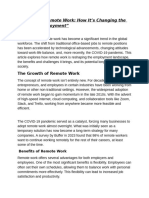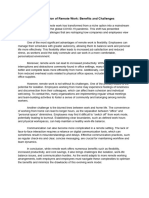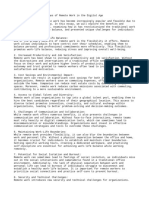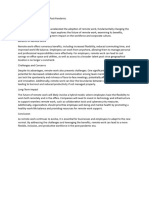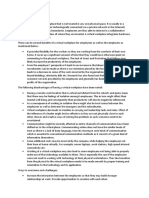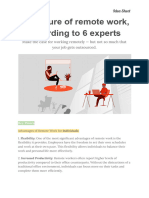The Benefits and Drawbacks of Remote Work
The Benefits and Drawbacks of Remote Work
Uploaded by
lilixinhdep11Original Title
Copyright
Available Formats
Share this document
Did you find this document useful?
Is this content inappropriate?
Report this DocumentCopyright:
Available Formats
The Benefits and Drawbacks of Remote Work
The Benefits and Drawbacks of Remote Work
Uploaded by
lilixinhdep11Copyright:
Available Formats
The Benefits and Drawbacks of Remote Work
Remote work, or telecommuting, has become increasingly popular, offering both benefits and
drawbacks for employees and employers alike. The shift towards remote work has been
accelerated by advancements in technology and the global pandemic, which have demonstrated
the feasibility and potential advantages of working from home.
One of the primary benefits of remote work is increased flexibility. Employees can often set
their own schedules and work from locations of their choice, which can lead to improved work-
life balance. The elimination of daily commutes saves time and reduces stress, allowing
employees to focus more on their work and personal life.
Remote work can also lead to increased productivity. Many employees find that they are more
productive when working from home due to fewer distractions and a more personalized work
environment. Additionally, remote work can reduce overhead costs for employers, such as
expenses related to office space, utilities, and office supplies.
However, remote work also presents several challenges. One major drawback is the potential
for social isolation. Working from home can lead to a sense of disconnection from colleagues,
which can impact team cohesion and collaboration. The lack of face-to-face interaction may
also hinder relationship-building and informal communication.
Another challenge is maintaining work-life boundaries. Without a clear separation between
work and home environments, employees may struggle to “switch off” and may experience
burnout. Establishing a dedicated workspace and setting boundaries for work hours are essential
for managing these challenges.
Additionally, remote work can present technical challenges, such as ensuring reliable internet
connections and access to necessary tools and resources. Employers must provide adequate
support and infrastructure to address these issues and ensure that remote work arrangements are
effective and efficient.
In conclusion, remote work offers significant benefits, including flexibility and increased
productivity, but also presents challenges such as social isolation and difficulty in maintaining
work-life boundaries. By addressing these challenges and implementing effective remote work
policies, organizations can maximize the advantages of telecommuting while minimizing its
drawbacks.
You might also like
- The Benefits and Challenges of Remote WorkDocument1 pageThe Benefits and Challenges of Remote WorkAngBagong Barangay SanJuanNo ratings yet
- The Rise of Remote WorkDocument2 pagesThe Rise of Remote WorkbarteksribdNo ratings yet
- The Benefits and Challenges of Remote Wor1Document2 pagesThe Benefits and Challenges of Remote Wor1AngBagong Barangay SanJuanNo ratings yet
- The Benefits and Drawbacks of Remote WorkDocument1 pageThe Benefits and Drawbacks of Remote Workganji98No ratings yet
- The Benefits and Challenges of Remote WorkDocument1 pageThe Benefits and Challenges of Remote Worklilixinhdep11No ratings yet
- Blog 3Document2 pagesBlog 3Zaineb MatiullahNo ratings yet
- The Benefits and Challenges of Remote WorkDocument2 pagesThe Benefits and Challenges of Remote WorkJuan BrattiNo ratings yet
- The Rise of Remote WorkDocument3 pagesThe Rise of Remote WorkHamd FatimaNo ratings yet
- 1Document2 pages1mundranehal3834No ratings yet
- Navigating The Remote Work RevolutionDocument8 pagesNavigating The Remote Work Revolutionsarfrazahmed34357No ratings yet
- Remote Work Pros and ConsDocument1 pageRemote Work Pros and ConssfgNo ratings yet
- Impact of Remote Work On Productivity and Work-Life BalanceDocument2 pagesImpact of Remote Work On Productivity and Work-Life Balance022MausamNo ratings yet
- Remote WorkDocument2 pagesRemote WorkEhab AlMukhaderNo ratings yet
- 2 Advantage and DisadvantageDocument19 pages2 Advantage and DisadvantageMariam MiliNo ratings yet
- 9Document2 pages9Irfan SadabNo ratings yet
- The Future of Remote Work: Pros and ConsDocument3 pagesThe Future of Remote Work: Pros and Consyrfgdvb27No ratings yet
- Advantages and Disadvantages of Remote WorkingDocument2 pagesAdvantages and Disadvantages of Remote WorkingThoa LeNo ratings yet
- Remote Working v2Document3 pagesRemote Working v2simaykoc.skNo ratings yet
- Lektura Prasy ArtykułDocument2 pagesLektura Prasy Artykułsteamimon2No ratings yet
- Essay 4Document1 pageEssay 4flitzzgaming3112No ratings yet
- The Benefits and Challenges of Remote WorkDocument2 pagesThe Benefits and Challenges of Remote WorkerkanaptiNo ratings yet
- A Study Into The Effects of An Increasingly Teleworking SocietyDocument4 pagesA Study Into The Effects of An Increasingly Teleworking Societystonehenge5No ratings yet
- The Rise of Remote Work: Transforming The Modern WorkplaceDocument1 pageThe Rise of Remote Work: Transforming The Modern WorkplaceDiego VargasNo ratings yet
- Remote Work BenefitsDocument1 pageRemote Work BenefitsAyeshaNo ratings yet
- The Impact of Remote Work On Productivity and WorkDocument3 pagesThe Impact of Remote Work On Productivity and WorkXaine PineraNo ratings yet
- The Future of Remote Work Post-PandemicDocument1 pageThe Future of Remote Work Post-PandemicnavinpkujurNo ratings yet
- Title 2Document2 pagesTitle 2pratheekshasnair002No ratings yet
- M Usman KhadimDocument2 pagesM Usman KhadimMuhammad Usman KhadimNo ratings yet
- Νέο Έγγραφο Του Microsoft WordDocument2 pagesΝέο Έγγραφο Του Microsoft Wordgianns200523No ratings yet
- Am Ethical Argument Essay Final DraftDocument9 pagesAm Ethical Argument Essay Final Draftapi-653628343100% (1)
- Remote Work Vs TelecommutingDocument3 pagesRemote Work Vs TelecommutingJaeNo ratings yet
- The Rise of Remote WorkDocument1 pageThe Rise of Remote WorkNimrod BecerroNo ratings yet
- Cons Work From HomeDocument2 pagesCons Work From HomeAyeshaNo ratings yet
- Mastering Remote Work: This comprehensive guide empowers you to succeed in the world of remote work.From EverandMastering Remote Work: This comprehensive guide empowers you to succeed in the world of remote work.No ratings yet
- WRI - Working From HomeDocument1 pageWRI - Working From Homechaudm22405caNo ratings yet
- Remote WorkDocument3 pagesRemote WorkGian John Rey FarroNo ratings yet
- The Advantages and Challenges of Remote WorkDocument3 pagesThe Advantages and Challenges of Remote WorkKane PleaseNo ratings yet
- The Impact of Remote Work On Employee Performance and WellDocument2 pagesThe Impact of Remote Work On Employee Performance and WellDrazen JovicNo ratings yet
- Benefits of Remote Work and How It Fuels Business Success - GigsterDocument1 pageBenefits of Remote Work and How It Fuels Business Success - GigsterdimahmadyNo ratings yet
- Wa0001.Document5 pagesWa0001.Sachin SharmaNo ratings yet
- The Revolutionary Evolution of Remote WorkDocument2 pagesThe Revolutionary Evolution of Remote Workiurascuiulia4No ratings yet
- TeleworkingDocument6 pagesTeleworkingКарина КолесникNo ratings yet
- Tele CommutingDocument8 pagesTele CommutingTourist PakistanNo ratings yet
- Business ReportDocument11 pagesBusiness Reportsaxena.utkarsh.usNo ratings yet
- Group ADocument8 pagesGroup AOmkar ThoratNo ratings yet
- 1Document2 pages1Hüseyin Sezer YıldırımNo ratings yet
- Proffessional Issuesdue On March 12thDocument3 pagesProffessional Issuesdue On March 12thSpeter MuleNo ratings yet
- Virtual WorkplaceDocument2 pagesVirtual WorkplaceJyotsna NandakumarNo ratings yet
- The Benefits and Challenges of Remote Work in The Digital AgeDocument3 pagesThe Benefits and Challenges of Remote Work in The Digital AgeJas PerNo ratings yet
- Teleworking EssayDocument1 pageTeleworking EssayMarianela AguirreNo ratings yet
- 12Document4 pages12Shirin KarwaniNo ratings yet
- Telecommuting A Growing TrendDocument8 pagesTelecommuting A Growing TrendLTennNo ratings yet
- Effective Telecommuting: Learn how to work efficiently and productively at homeFrom EverandEffective Telecommuting: Learn how to work efficiently and productively at homeNo ratings yet
- @annisuphere #Idea Sheet - Future of Remote WorkDocument12 pages@annisuphere #Idea Sheet - Future of Remote WorkninaNo ratings yet
- Working From HomeDocument4 pagesWorking From Home23521346No ratings yet
- Work From HomeDocument17 pagesWork From Home5trrz6p9gzNo ratings yet
- The Evolution of Remote Work Navigating The Future of Flexible EmploymentDocument2 pagesThe Evolution of Remote Work Navigating The Future of Flexible EmploymentAntoine MNo ratings yet
- Future of Remote Work Part 1Document5 pagesFuture of Remote Work Part 1huraira9111No ratings yet
- A306 Management Information Systems and The Networked Society AssignmentDocument4 pagesA306 Management Information Systems and The Networked Society Assignmentapi-3695734No ratings yet
- The Impact of Climate Change On Coastal CommunitiesDocument1 pageThe Impact of Climate Change On Coastal Communitieslilixinhdep11No ratings yet
- The Importance of Maintaining A Healthy LifestyleDocument1 pageThe Importance of Maintaining A Healthy Lifestylelilixinhdep11No ratings yet
- #218594 Difficulty: Moderate #13318 Difficulty: ModerateDocument4 pages#218594 Difficulty: Moderate #13318 Difficulty: Moderatelilixinhdep11No ratings yet
- SpringboardDocument4 pagesSpringboardlilixinhdep11No ratings yet







